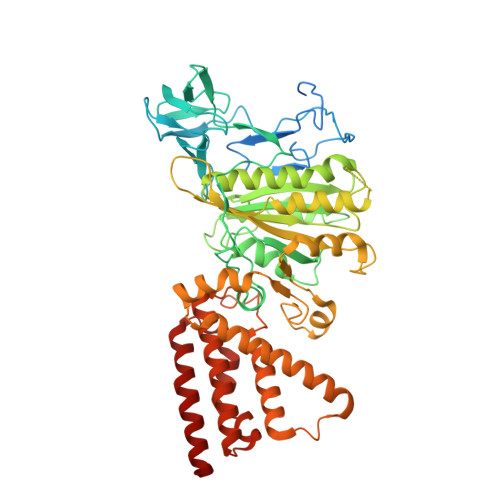Nucleotide binding states of subunit A of the A-ATP synthase and the implication of P-loop switch in evolution.
Kumar, A., Manimekalai, M.S., Balakrishna, A.M., Jeyakanthan, J., Gruber, G.(2010) J Mol Biology 396: 301-320
- PubMed: 19944110
- DOI: https://doi.org/10.1016/j.jmb.2009.11.046
- Primary Citation of Related Structures:
3I4L, 3I72, 3I73, 3IKJ - PubMed Abstract:
The crystal structures of the nucleotide-empty (A(E)), 5'-adenylyl-beta,gamma-imidodiphosphate (A(PNP))-bound, and ADP (A(DP))-bound forms of the catalytic A subunit of the energy producer A(1)A(O) ATP synthase from Pyrococcus horikoshii OT3 have been solved at 2.47 A and 2.4 A resolutions. The structures provide novel features of nucleotide binding and depict the residues involved in the catalysis of the A subunit. In the A(E) form, the phosphate analog SO(4)(2-) binds, via a water molecule, to the phosphate binding loop (P-loop) residue Ser238, which is also involved in the phosphate binding of ADP and 5'-adenylyl-beta,gamma-imidodiphosphate. Together with amino acids Gly234 and Phe236, the serine residue stabilizes the arched P-loop conformation of subunit A, as shown by the 2.4-A structure of the mutant protein S238A in which the P-loop flips into a relaxed state, comparable to the one in catalytic beta subunits of F(1)F(O) ATP synthases. Superposition of the existing P-loop structures of ATPases emphasizes the unique P-loop in subunit A, which is also discussed in the light of an evolutionary P-loop switch in related A(1)A(O) ATP synthases, F(1)F(O) ATP synthases, and vacuolar ATPases and implicates diverse catalytic mechanisms inside these biological motors.
Organizational Affiliation:
School of Biological Sciences, Nanyang Technological University, Singapore, Republic of Singapore.






















